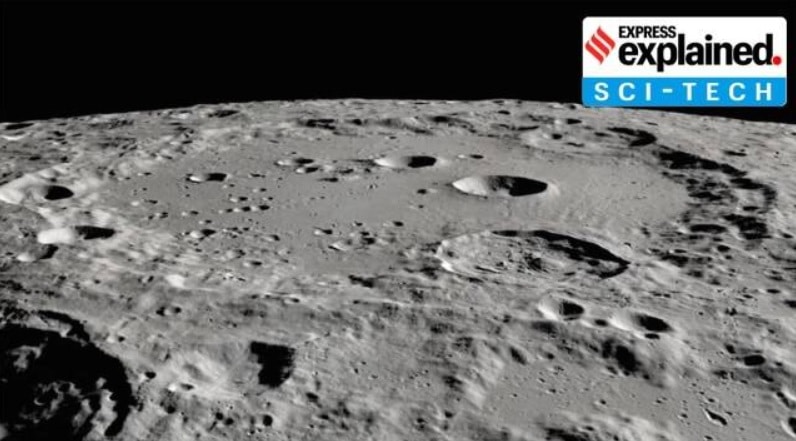What’s in today’s article?
- Why in news?
- What is Chandrayaan-3 Mission?
- Why hasn’t any spacecraft ever landed near the lunar south pole?
- Why do scientists want to explore the lunar south pole?
- Why don’t some parts of the lunar polar regions receive any sunlight?
Why in news?
- India is set to launch Chandrayaan-3, India’s third lunar mission, from Andhra Pradesh’s Sriharikota on July 14.
- If everything goes well, the Chandrayaan-3 will become the world’s first mission to soft-land near the lunar south pole.
- All the previous spacecraft to have landed on the Moon have landed in the equatorial region, a few degrees latitude north or south of the lunar equator.
What is Chandrayaan-3 Mission?
- Chandrayaan-3 (“mooncraft”) is a planned 3rd lunar exploration mission by the ISRO to demonstrate end-to-end capability in –
- Safe landing (through the lander Vikram – after Vikram Sarabhai, the father of the Indian space programme) and
- Roving (through the rover Pragyan) on the lunar surface.
- Unlike Chandrayaan-2, it will not have an orbiter and its propulsion module will behave like a communications relay satellite.
- Chandrayaan-3 interplanetary mission has three major modules: the Propulsion module, Lander module, and Rover.
News Summary: Chandrayaan-3 mission – Why ISRO wants to explore the Moon’s south pole
- The Chandrayaan-3 will reach the lunar orbit almost a month after its launch, and its lander, Vikram, and rover, Pragyaan, are likely to land on the Moon on August 23.
- The landing site of the latest mission is more or less the same as the Chandrayaan-2: near the south pole of the moon at 70 degrees latitude.
- Even China’s Chang’e 4, which became the first spacecraft to land on the far side of the moon — the side that does not face the earth — landed near the 45-degree latitude.
Why hasn’t any spacecraft ever landed near the lunar south pole?
- Easier and safer to land near the equator
- The terrain and temperature are more hospitable and conducive for a long and sustained operation of instruments.
- The surface here is even and smooth, very steep slopes are almost absent, and there are fewer hills or craters.
- Sunlight is present in abundance, at least on the side facing the earth, thus offering a regular supply of energy to solar-powered instruments.
- Difficult polar regions of the Moon
- The polar regions of the Moon, are a very different, and difficult, terrain.
- Many parts lie in a completely dark region where sunlight never reaches, and temperatures can go below 230 degrees Celsius.
- Lack of sunlight and extremely low temperatures create difficulty in the operation of instruments.
- In addition, there are large craters all over the place, ranging from a few centimetres in size to those extending to several thousands of kilometres.
Why do scientists want to explore the lunar south pole?
- Exploring the unexplored
- Due to their rugged environment, the polar regions of the Moon have remained unexplored.
- There are indications of the presence of ice molecules in substantial amounts in the deep craters in this region.
- India’s 2008 Chandrayaan-1 mission indicated the presence of water on the lunar surface with the help of its two instruments onboard.
- Clue about solar region
- The extremely cold temperatures here mean that anything trapped in the region would remain frozen in time, without undergoing much change.
- The rocks and soil in Moon’s north and south poles could therefore provide clues to the early Solar System.
Why don’t some parts of the lunar polar regions receive any sunlight?
- Unlike the Earth, whose spin axis is tilted with respect to the plane of the Earth’s solar orbit by 23.5 degrees, the Moon’s axis tilts only 1.5 degrees.
- Because of this unique geometry, sunlight never shines on the floors of a number of craters near the lunar north and south poles.
- These areas are known as Permanently Shadowed Regions, or PSRs.
Q1) What is a rover?
A rover is a type of robotic vehicle designed to explore the surface of celestial bodies such as planets, moons, or asteroids. Rovers are primarily used in space exploration missions to gather scientific data, capture images, and perform experiments in environments where it may be challenging or impossible for humans to go. Rovers are equipped with various instruments and tools to perform their scientific tasks. These can include cameras, spectrometers, drills, robotic arms, and other sensors. They are typically controlled remotely by scientists and engineers on Earth, who send commands and receive data from the rover via a communication link.
Q2) What are Permanently Shadowed Regions of Moon?
Permanently Shadowed Regions (PSRs) on the Moon are areas that receive little or no direct sunlight due to the peculiarities of the Moon’s topography and its axial tilt. These regions are located primarily near the lunar poles, specifically the South Pole and the North Pole, and are characterized by deep craters and depressions that are constantly in shadow.
Source: Chandrayaan-3 mission: Why ISRO wants to explore the Moon’s south pole | The Hindu
Last updated on August, 2025
→ UPSC Mains Admit Card 2025 has been released on 14th August at www.upsc.gov.in.
→ UPSC Mains 2025 will be conducted on 22nd August 2025.
→ UPSC Notification 2025 was released on 22nd January 2025.
→ UPSC Calendar 2026 is released on 15th May, 2025.
→ UPSC Prelims Question Paper 2025 and Unofficial Prelims Answer Key 2025 are available now.
→ UPSC Prelims Result 2025 is out now for the CSE held on 25 May 2025.
→ The UPSC Vacancy 2025 were released 1129, out of which 979 were for UPSC CSE and remaining 150 are for UPSC IFoS.
→ UPSC Prelims 2026 will be conducted on 24th May, 2026 & UPSC Mains 2026 will be conducted on 21st August 2026.
→ The UPSC Selection Process is of 3 stages-Prelims, Mains and Interview.
→ UPSC Result 2024 is released with latest UPSC Marksheet 2024. Check Now!
→ UPSC Toppers List 2024 is released now. Shakti Dubey is UPSC AIR 1 2024 Topper.
→ Also check Best IAS Coaching in Delhi















